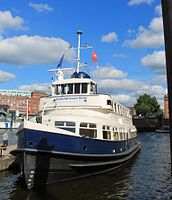Great Michel
|
||||||||||||||
|
||||||||||||||
|
||||||||||||||
|
||||||||||||||
The Grosser Michel is a former Hamburg harbor ferry . The diesel-electric powered ship was built in 1955 as a type ship for HADAG , decommissioned in 1991 and after being converted into a seaworthy hotel and event ship, it now mainly operates in the port of Hamburg .
history
The port ferry Grosser Michel was built at the Oelkers shipyard and is of type IIIb-S. Sister ships were the Bergedorf and Jungfernstieg .
1955 construction at the Oelkers shipyard
The Grosser Michel was built in 1955 at the Johann Oelkers shipyard in Hamburg-Wilhelmsburg ; it was launched on June 21, 1955 and delivered to HADAG on December 20 of that year. For a long time, this shipyard was HADAG's largest supplier with seven port ferries.
1975 Renaming to Moorburg
On August 21, 1975 the name was changed to Moorburg . The previously relatively dark upper deck became lighter, as large side windows were built into the ceiling and a large skylight. In addition to regular service, the Moorburg, with its extremely stable hull, was also popular as an icebreaker in the port of Hamburg in winter . The ship was built with ice class in accordance with the certification of the ship investigation commission and was therefore approved for light ice drift all year round.
1991 End as a harbor ferry and conversion as an event and hotel ship Grosser Michel
In 1991 the Moorburg was decommissioned by HADAG and sold to the merchant M. Doose in November of the same year. In 1992 the ship was sold to the 1st Congress Shipping Company and extensively converted into a hotel and restaurant ship. As part of these interior renovations, a conference room, a bar and a restaurant were created, as well as cabins with a shower room and a wellness area with a sauna. The technical area and the drive system were also overhauled and modernized in order to meet the requirements of the supervisory authorities and the current demands of passengers. An additional 50 Hertz alternating current network was installed, which is supplied by the new port diesel generator, which has a nominal output of 48 kW. After the renovation work, it was renamed Grosser Michel again.
Nowadays, the former harbor ferry (since July 2016) has a license for 80 passengers / day guests, is also navigable as a hotel ship with three double cabins and two single cabins for 8-10 berths and makes regular trips.
Used by HADAG as Grosser Michel and Moorburg
The ferry was used in port traffic from 1956, the times when HADAG had a high number of passengers; in the record year 1958, 21.3 million passengers were carried. For comparison, the number of passengers in 2011 was 7.65 million and in 2012 around 8 million passengers, i.e. H. far below half compared to 1958. The Moorburg also served as a ferry and icebreaker as well as a tug , because in autumn HADAG's own pontoons , which were not on piles in the lower Elbe river, were moved to winter storage. They were anchored and there was always the risk that the anchors would not hold in the ice. In the spring, the pontoons were towed back to their locations and anchored.
home port
The home port is still Hamburg and after renovations from 1992 to 1994, the ship found its regular berth at the HADAG Sandtorhöft jetty near Hamburg's city sports boat harbor at the end of the 1990s.
Technical specifications
With a length of 30.1 meters, width of 7.5 meters and a draft of 3.2 meters, the riveted ship has a construction displacement of 255 m³. The drive system has a primary drive power of 380 HP (280 kW ) at a nominal speed of 500 rpm. It is supported by a six-cylinder - Deutz - Diesel engine provided the type V6M536. At that time, the engine type was also often used on larger ships as a diesel generator to generate electricity, including the Cap-San class ships built in 1960/1961 , which have four of these engines with eight cylinders on board. They are also still in operation today on the museum ship Cap San Diego .
The drive of this historic harbor ferry is diesel-electric, the drive diesel engine drives a generator with 240 kW nominal power (voltage 400 volts ) and supplies the electric traction motor with a nominal power of 221 kW at a voltage of 380 volts and a nominal speed of 1250 / min, which over a gear is reduced to the propeller speed of 180 / min. The propeller rotates to the left and has a diameter of 2.5 meters. It gives the ship a speed of 11 knots . The diesel-electric drive system was supplied by AEG-Schiffbau in Hamburg.
The power supply for the 110 V direct current on-board network is provided while the vehicle is in motion by the on-board network generator driven by the main diesel engine with 20 kW at 1800 rpm. A port diesel of the type MWM KDW415Z with 16 HP rated power at 1000 rpm, which drove an AEG port generator with 10 kW rated power at 115 V, provided the power supply in the port.
The number of permitted passengers was based on the route:
- 607 passengers in the port of Hamburg
- 489 passengers to Glückstadt
- to Cuxhaven 367 passengers
See also
literature
- Arnold Kludas : One Hundred Years of HADAG Ships, 1888–1988 . Koehlers Verlagsgesellschaft, Herford; 1988, ISBN 3-7822-0446-8 .
- Jan Mordhorst: The green fleet. The history of a means of transport . In: Remarkable things from the Hanseatic city. Hamburger Klönschnack. No. 1. Klaus-Schümann-Verlag, Hamburg September 2002
- Ralf Witthohn: HADAG: On Jungfernstieg and Reeperbahn over the Elbe . In: Deutsche Seeschifffahrt , issue 10/2009, pp. 60/61, Hamburg 2009



